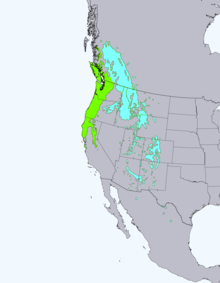Douglas-fir
| Douglas-fir | |
|---|---|
 |
|
| Coast Douglas firs in Marysville, Washington | |
| Scientific classification | |
| Kingdom: | Plantae |
| Division: | Pinophyta |
| Class: | Pinopsida |
| Order: | Pinales |
| Family: | Pinaceae |
| Genus: | Pseudotsuga |
| Species: | P. menziesii |
| Binomial name | |
|
Pseudotsuga menziesii (Mirb.) Franco |
|
 |
|
|
Green: Coast Douglas-fir (Pseudotsuga menziesii var. menziesii)
Blue: Rocky Mountain Douglas-fir (Pseudotsuga menziesii var. glauca)
|
|
Pseudotsuga menziesii, commonly known as Douglas fir or Douglas-fir, is an evergreen conifer species native to western North America. One variety, the coast Douglas fir, grows along the Pacific Ocean from central British Columbia south to central California. A second variety, the Rocky Mountain Douglas fir, grows in the Rocky Mountains from British Columbia south to Mexico. The tree is dominant in western Washington. It is extensively used for timber, worldwide.
The common name honors David Douglas, a Scottish botanist and collector who first reported the extraordinary nature and potential of the species. The common name is misleading since it is not a true fir, i.e., not a member of the genus Abies. For this reason the name is often written as Douglas-fir (a name also used for the genus Pseudotsuga as a whole).
The specific epithet, menziesii, is after Archibald Menzies, a Scottish physician and rival naturalist to David Douglas. Menzies first documented the tree on Vancouver Island in 1791. Colloquially, the species is also known simply as Doug-fir or as Douglas pine (although the latter common name may also refer to Pinus douglasiana).
One Coast Salish name for the tree, used in the Halkomelem language, is lá:yelhp.
Douglas firs are medium-size to extremely large evergreen trees, 20–100 metres (70–330 ft) tall (although only coast Douglas firs reach such great height). The leaves are flat, soft, linear, 2–4 centimetres (0.8–1.6 in) long, generally resembling those of the firs, occurring singly rather than in fascicles; they completely encircle the branches, which can be useful in recognizing the species. The female cones are pendulous, with persistent scales (unlike true firs), and are distinctive in having a long tridentine (three-pointed) bract that protrudes prominently above each scale (it resembles the back half of a mouse, with two feet and a tail).
...
Wikipedia

